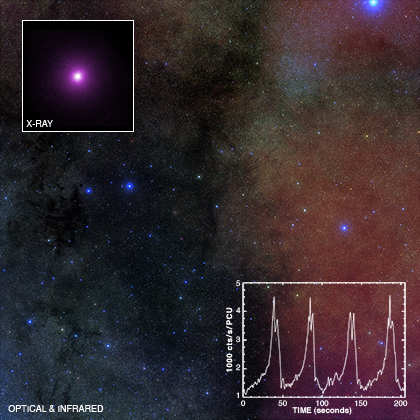Taking the Pulse of a Black Hole System

This optical and infrared image from the Digitized Sky Survey shows the crowded field around the binary system GRS 1915+105 (GRS 1915 for short) located near the plane of our Galaxy. The top-left inset shows a close-up of the Chandra image of GRS 1915 , and the bottom-right inset shows the remarkable "heartbeats" seen in the X-ray light from this system. Using Chandra and the Rossi X-ray Timing Explorer (RXTE), astronomers have discovered what drives these heartbeats and given new insight into the ways that black holes can regulate their intake and severely curtail their growth.
GRS 1915 contains a black hole about 14 times the mass of the Sun that is feeding off material from a nearby companion star. As the material swirls toward the black hole, a disk forms. The black hole in GRS 1915 has been estimated to rotate at the maximum possible rate, allowing material in the inner disk to orbit very close to the black hole -- at a radius only 20% larger than the event horizon -- where the material travels at 50% the speed of light.
http://www.chandra.harvard.edu/photo/2011/g1915/
-Megan Watzke
Category:
- Log in to post comments
